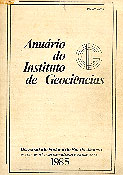O Espaço Agrário Fluminense: Estrutura e Transformações
DOI:
https://doi.org/10.11137/1985_0_74-87Abstract
Starting out from the conception that agrarian space is a subspace created by rural activities within a totality which includes the city with its multiple varied interactions, the present study focuses on the agrarian space of the state of Rio de Janeiro as affected by the urban-industrial economy. It identifies is as a traditional agrarian space in which the effects of urban growth are making themselves felt in spatially differentiated and structurally contradictory forms. The internal disparities are seen in the context of the social, economic and political formation of the state, from which emerge, as agents of considerable importance and on different scales, the coffee economy which conditioned the settlement and appropriation of the territory and, on the other hand, the functions of Rio de Janeiro as a port, a centre of political power and a national metropolis. With a background of dairy-farming, replacing coffee-growing in almost the whole of the state, and single-crop sugarcane cultivation in the Baixada Campista, the agrarian space of the state of Rio de Janeiro illustrates overall limitations and problems of the state's economy, within a framework of immobility or feeble growth. This formally stationary framework has been passing through changes in organization and structure which have reflected, during the past thirty years, different ways in which the state of Rio de Janeiro has shared in the overall process of the country's development reflecting, at one and the same time, capitalist expansion in the rural sector and its articulations with various political actions aimed directly or not at that sector. As a result of their extent and their social and economic implications, a number of important variables are referred to in this study as indicators of changes. They are variables referring to land use, recorded in the Censures from 1950 to 1980, and others characteristic of the modes of production, brought up in the course of field surveys. The expansion and modernization of cattle-raising in specifically defined areas in the state, the widespread fall-off in permanent cultivation and the increase in temporarily cultiva>;ted areas reflect new options for producers in connection with less expensive and more profitable activities. The strengthening of sugarcane cultivation, the extension of silviculture, especially since 1970, and the resurgence of coffee-growing display the effects of agricultural policies based on subsidized credit. Of the various forms of innovatibn in the state rural area which are focused on in this study, none shows the direct interference of Rio de Janeiro as a consumer market. Not even cattle-raising practised on the enterprise model on the periphery closest to the city is fundamentally directed towards Rio's consumer market, except for dairy production of the beef cattle produced there, only 10% or so are earmarked for this market. In the coastal lowlands of the Lake Region, specialization in the production of cows and bulls for breeding purposes, which is being consolidated in conjunction with the pastoral areas of Minas Gerais, Espirito Santo, Goias and Mato Grosso, offers the most obvious prood of the alienation of the producing area from the immediate market of Greater Rio. The geographical distribution and configuration of the dynamic segments and the stagnant pockets in the state point to another feature of its agrarian framework. The great motor-way axes which bring Rio de Janeiro into contact with the other metropolises in the Southeast or with the Northeast via the coastal highway are today the great lines along which the modernization of rural activities and new social relations of production are being diffused, so creating a new agrarian framework which has little or nothing to do with the previous one or with the great metropolitan market. From the above-mentioned frame of reference, it is quite clear that the agrarian space of the state of Rio de Janeiro is being transformed under the action of forces superior to market ones, forces which transcend the system of internal relations of the state itself, embodying the process of capital enrichment of the rural areas and a new spatial structuring linked to the projection of Rio de Janeiro on a national scale, more than to its local or regional action.Downloads
Download data is not yet available.
Downloads
Published
1985-01-01
How to Cite
Galvão, M. do C. C. (1985) “O Espaço Agrário Fluminense: Estrutura e Transformações”, Anuário do Instituto de Geociências. Rio de Janeiro, BR, 9, pp. 74–87. doi: 10.11137/1985_0_74-87.
Issue
Section
Departamento de Geografia
License
This journal is licensed under a Creative Commons — Attribution 4.0 International — CC BY 4.0, which permits use, distribution and reproduction in any medium, provided the original work is properly cited.















